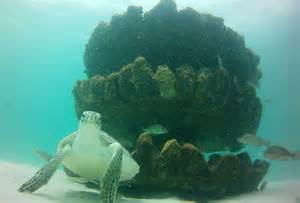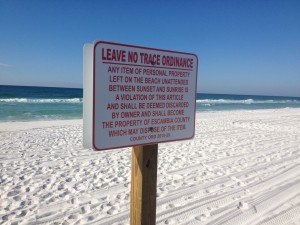It is August, we are just off another successful Sea Turtle Baby Shower event in the Pensacola area, and we are in peak season for sea turtle hatching. Those little guys have a tough road to follow trying to emerge from their nest to reach the open waters of the Gulf of Mexico. Within the nest the young wait for cooler temperatures and no vibrations to begin their climb towards the surface. Once they have emerged, they locate the shortwave light of the moon and stars reflecting off of the water and head for sea. However, ghost crabs, fox, and coyotes, all excavate nests and consume hatchlings running across the sand.

This sea turtle frequents the nearshore snorkel reef at Park East in Escambia County.
Photo: Robert Turpin
But these predators are not alone on Pensacola Beach. Humans have moved onto the island in large numbers. Vehicle tracks, large holes, tents, chairs, and our pets all are obstacles for the young in their journey to the sea. One of the larger problem has been lighting. Most of our buildings are well lit for safety. We tend to use shortwave lighting systems that produce bright white lights similar to what the moon and stars reflect off of the Gulf – many times brighter. Because of this many of the hatchlings will disorient and travel towards the buildings and roads instead of the open Gulf… this certainly is not good. Disoriented turtles will wonder onto road ways where they are hit by cars, and under or around buildings where they can become lost or come in contact with house pets and rats – not to mention the increase time on land will increase the chance of a native predator finding them. If they make it until morning, there is the problem of shorebirds and the sun – the chances of the hatchlings surviving a disorientation are not good.
There are a variety of reasons why sea turtle populations are low enough to have them listed, but this is certain one of the larger problems. Data from Escambia County extending back to 1996 show that, on average, 48% of the sea turtle nests disorient – and it has been as high as 70%.
So What Can We Do to Help the 2017 hatchlings?
First, we are having a big year for nesting. Mark Nicholas, GINS and permit holder for sea turtle work here, indicated there were 101 nests in our area this year… we have a chance to have a really big and successful sea turtle nesting season – with a little help from you.
- Clean the beach before you head in for the night. Most panhandle counties actually have a “Leave No Trace” ordinance which requires the removal of chairs, tents, etc. – but be sure the holes are filled in and the trash is removed as well.
- For inside lighting – turn down the lights and/or close the currents. Exterior lighting should be “turtle friendly” – meaning long wavelength – which means yellow/red. Most panhandle counties have an ordinance for exterior lighting. In Escambia County residents have until 2018 to comply – but we encourage you to make those changes as soon as you can to help the turtles hatching this season. “Turtle Friendly” would include the big three – KEEP IT LOW, KEEP IT LONG, AND KEEP IT SHIELDED. Keep it low meaning as low to the ground as you can. If that is not possible, place a shield on the fixture to direct the light down to where you are walking and not out to the beach. Keep it long refers to the wavelength, longer than 560 nanometers, which is in the yellow/red range of color. Studies show that hatchlings are attracted to the shortwaves (white/blue) end of the spectrum. Having long wave lighting will increase the chances of the hatchling finding the shortwaves from stars off of the Gulf. You will want to keep the illumination down as well. We recommend 25W bulbs, which is bright enough to see and reduces the chance of attracting a young turtle.
- Keep a distance from the marked nests – remember that vibrations (even from your walking) can cause the hatchlings to wait – and waiting too long can cost them their lives. If you are lucky enough to see baby turtles crawling for the Gulf – do not use flash photography and do not use flash lights – unless they have a protective red film producing a low intensity red light.
- If you find a group of hatchlings that are obviously disoriented, contact the local authority in your area. In Escambia County we recommend calling the sheriff substation on the island or the Gulf Breeze dispatch – who will contact the National Park.
If you have questions about turtle lighting options, the current county ordinances designed to help island wildlife, or the Turtle Friendly Beaches program, contact your County Extension Sea Grant Agent.

Many counties in the panhandle have lighting and barrier ordinances to protect wildlife and workers.
Photo: Rick O’Connor
- St. Joe Red Tide Claiming Terrapins - December 15, 2025
- The 2025 Snake Watch Report for the Pensacola Bay Area - December 15, 2025
- Rattlesnakes on Our Barrier Islands; Part 2 – Prey Selection - December 15, 2025
